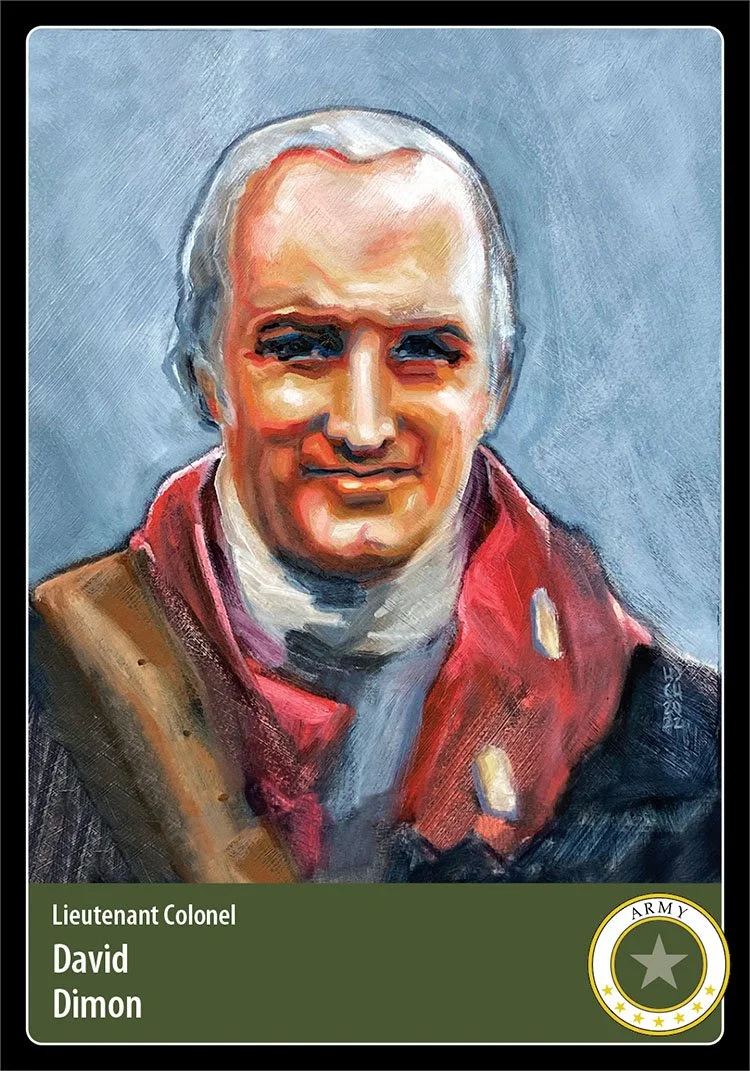Hero Card 22, Card Pack 2
There are no known historical images of LTC David Dimon. Artist’s impression by Christine Westrich.
Hometown: Mecklenburg County, NC
Branch: Continental Army
Unit: Salisbury District Brigade of Militia
Date of Sacrifice: February 1, 1781 - KIA, Battle of Cowan’s Ford, NC
Age: 34
Conflict: Revolutionary War, 1775-1783
Lieutenant Colonel David Dimon served under General George Washington in the Continental Army and fought in the bloody Battle of Brandywine (also known as the Battle of Brandywine Creek) near Chadds Ford, Pennsylvania.
According to the American Battlefield Trust:
On September 11, 1777, General George Washington was determined to prevent the British from capturing the American seat of government, Philadelphia. Opposing Washington was Sir William Howe and an army of 15,500 British Regulars and Hessian troops. Despite putting up a stiff resistance, the Continentals were eventually overrun by Howe’s men.
To prevent the defeat turning into disaster Washington ordered Nathanael Greene’s division to act as a rear-guard so that the Continental Army could escape to the northeast. Greene’s brave men counterattacked, going toe-to-toe with British along the crest of Birmingham Hill.
When night fell, the remaining Americans fell back in an orderly retreat, led in part by the Marquis de Lafayette. Although wounded, the charismatic young Frenchman remained on the field to ensure an organized withdrawal.
The crushing defeat allowed the British to occupy Philadelphia, but the bulk of the Continental Army survived to fight another day. By many measures—duration, geographic spread of the fighting, number of troops engaged—it was the biggest battle of the Revolution. The loss at Brandywine cost the fledgling nation its capital, but it earned new respect for troops determined to fight on to ultimate victory.
Lieutenant Colonel David Dimon survived the Battle of Brandywine but contracted a “bilious fever” after a march in a drenching rain. He died a few days after the battle, on September 18, 1777. While Dimon did not live to see the final victory of the American Revolution, his death came little more than a year after the new nation declared its independence from Britain. He gave his life as a free man, for the cause of American liberty.
Sources
Artist’s Impression: Christine Westrich
American Battlefield Trust: Brandywine
American Battlefield Trust: Battle of Brandywine: Proving the Patriots’ Mettle
Historical Register of Officers in the Continental Army during the War of the Revolution
National Archives—Founders Online: To George Washington from Brigadier General Samuel Holden Parsons, 12 June 1777
Brandywine Soldiers: David Dimon
Geni.com: Col. David Dimon
Library of Congress: The history of Fairfield, Fairfield County, Connecticut, from the settlement of the town in 1639 to 1818





